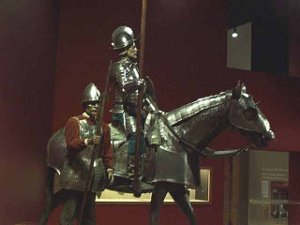 Conquistadores
terrific, especially the downstairs exhibit of 400 years of history.
Conquistadores
terrific, especially the downstairs exhibit of 400 years of history.
Well, by now we've seen more of Albuquerque, and have more to tell. We visited the Albuquerque Museum of Art and History, and we thought it was  Conquistadores
terrific, especially the downstairs exhibit of 400 years of history.
Conquistadores
terrific, especially the downstairs exhibit of 400 years of history.
Between 1702 and 1711 the Duke of Alburquerque (note the extra "r" in the name) was Viceroy of all of New Spain in North and Central America. One of the treasures in the basement is a 300-year old armorial wall hanging, a Repostero, which was presented to the city by the 18th Duke of Alburquerque when he visited the city on its 250th anniversary in 1956.
As a matter of fact, the Conquistadores found New Mexico very tough going indeed. Early Entradas were repulsed by the Pueblo Indians. A heavily armed Entrada was mounted in anticipation of finding the fabulous seven cities of gold. They defeated the Pueblo Indians, but there was no treasure to loot as there had been in Mexico. So, many of the Spanish returned to Mexico or wandered elsewhere. Meanwhile acting Governor Cuervo notified the King and Viceroy that he had founded a city (a bit of an exaggeration) and named it after the Duke. Not only was there no treasure to loot, but the city was  Children's reenactment costumes
constantly under attack by raiding parties of Apaches, and later, Comanches.
Children's reenactment costumes
constantly under attack by raiding parties of Apaches, and later, Comanches.
The museum exhibits, with interesting explanatory captions, detail the arms and armor of the Conquistadores, and later farm implements, church paraphernalia, tools for carpentry and weaving, and brings the city up to the twentieth century. The building is new and well laid out, and the exhibits are first rate. From our perspective, this museum is a must for Albuquerque visitors.
The art museum upstairs interested us less; there seemed to be mostly traveling exhibits, including one on the religious art of Tibet. But we admired several of the pieces in the sculpture garden.
We also paid a brief visit to the Holocaust Museum, operated out of a storefront on Central Avenue in downtown Albuquerque. The museum has displays about genocide against the Jews by the Nazis, against the Armenians by the Turks, and also discusses hate-motivated political acts such as the Bataan Death March, the interning of the Nisei, and mentions the forced relocations of the American Indians. The museum was opened in response to the wave of Holocaust denials in Europe.
 View from Sandia Mountain
View from Sandia Mountain
We continued driving around the city, stopping to see the new and elaborate Sandia Casino north of town, which certainly rivals many of the Las Vegas establishments. We didn't stay to contribute to the tribal coffers, so we can't tell you if the odds are good or bad!
We noted that the aerial tramway was open for business, but decided it was too cold for a tram ride, so the next morning, on our way out of town, we drove up the highway to Sandia Crest. As we braved the chilly winds, bundled up in Shetland sweaters, we were very happy we hadn't taken the tram! The view from the summit is indeed magnificent, as the mountain towers a mile high above the city of Albuquerque. It looks like one of those satellite images where you see the whole city laid out.